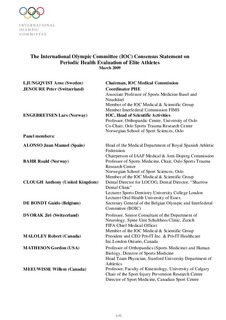| dc.contributor.author | Ljungqvist, Arne | |
| dc.contributor.author | Jenoure, Peter | |
| dc.contributor.author | Engebretsen, Lars | |
| dc.contributor.author | Alonso, Juan Manuel | |
| dc.contributor.author | Bahr, Roald | |
| dc.contributor.author | Clough, Anthony | |
| dc.contributor.author | De Bondt, Guido | |
| dc.contributor.author | Dvorak, Jiri | |
| dc.contributor.author | Maloley, Robert | |
| dc.contributor.author | Matheson, Gordon | |
| dc.contributor.author | Meeuwisse, Willem | |
| dc.contributor.author | Meijboom, Erik | |
| dc.contributor.author | Mountjoy, Margo | |
| dc.contributor.author | Pelliccia, Antonio | |
| dc.contributor.author | Schwellnus, Martin | |
| dc.contributor.author | Sprumont, Dominique | |
| dc.contributor.author | Schamasch, Patrick | |
| dc.contributor.author | Gauthier, Jean-Benoit | |
| dc.contributor.author | Dubi, Christophe | |
| dc.contributor.author | Stupp, Howard | |
| dc.contributor.author | Thill, Christian | |
| dc.date.accessioned | 2010-09-01T12:39:41Z | |
| dc.date.available | 2010-09-01T12:39:41Z | |
| dc.date.issued | 2009 | |
| dc.identifier | Seksjon for idrettsmedisinske fag / Department of Sports Medicine | |
| dc.identifier.citation | British Journal of Sports Medicine. 2009, 43(9), 631-643 | en_US |
| dc.identifier.issn | 0306-3674 | |
| dc.identifier.uri | http://hdl.handle.net/11250/170633 | |
| dc.description | I Brage finner du siste tekst-versjon av artikkelen, og den kan inneholde ubetydelige forskjeller fra forlagets pdf-versjon. Forlagets pdf-versjon finner du på http://bjsm.bmj.com: dx.doi.org/10.1136/bjsm.2009.064394 / In Brage you'll find the final text version of the article, and it may contain insignificant differences from the journal's pdf version. The original publication is available at http://bjsm.bmj.com: dx.doi.org/10.1136/bjsm.2009.064394 | en_US |
| dc.description.abstract | The Olympic Games is the largest sport event in the world. In Beijing, 10 500 athletes competed, selected from a large group of elite athletes in 204 countries. Sports participation on the elite level, aside from winning medals, fame and other rewards, is also important from a health perspective. There is no longer any doubt that regular physical activity reduces the risk of premature mortality in general, and of coronary heart disease, hypertension, colon cancer, obesity and diabetes mellitus in particular. The question is whether the health benefits of sports participation outweigh the risk of injury and long-term disability, especially in high-level athletes. Sarna et al1 have studied the incidence of chronic disease and life expectancy of former male world-class athletes from Finland in endurance sports, power sports and team sports. The overall life expectancy was longer in the high-level athlete compared with a reference group (75.6 vs 69.9 years). The same group also showed that the rate of hospitalisation later in life was lower for endurance sports and power sports compared with the reference group.2 This resulted from a lower rate of hospital care for heart disease, respiratory disease and cancer. However, the athletes were more likely to have been hospitalised for musculoskeletal disorders. Thus, the evidence suggests that although there is a general health benefit from sports participation, injuries represent a significant side effect. | en_US |
| dc.language.iso | eng | en_US |
| dc.publisher | BMJ | en_US |
| dc.subject | acute disease | en_US |
| dc.subject | athletic injuries | en_US |
| dc.subject | cardiovascular diseases | en_US |
| dc.subject | prevention | en_US |
| dc.subject | control | en_US |
| dc.subject | chronic disease | en_US |
| dc.subject | data collection | en_US |
| dc.subject | data mining | en_US |
| dc.subject | evidence-based medicine | en_US |
| dc.subject | forecasting | en_US |
| dc.subject | health status | en_US |
| dc.subject | sports medicine | en_US |
| dc.subject | preventive health services | en_US |
| dc.title | The International Olympic Committee (IOC) Consensus Statement on periodic health evaluation of elite athletes March 2009 | en_US |
| dc.type | Journal article | en_US |
| dc.type | Peer reviewed | en_US |
| dc.subject.nsi | VDP::Social science: 200::Social science in sports: 330::Other subjects within physical education: 339 | en_US |
| dc.source.pagenumber | 631-643 | en_US |
